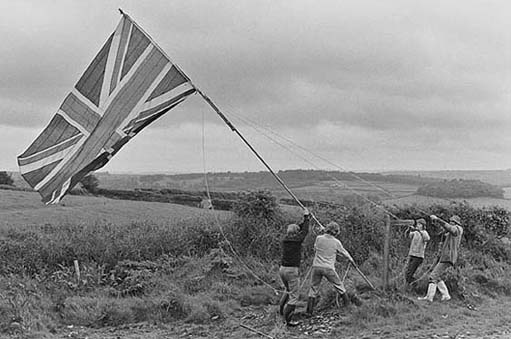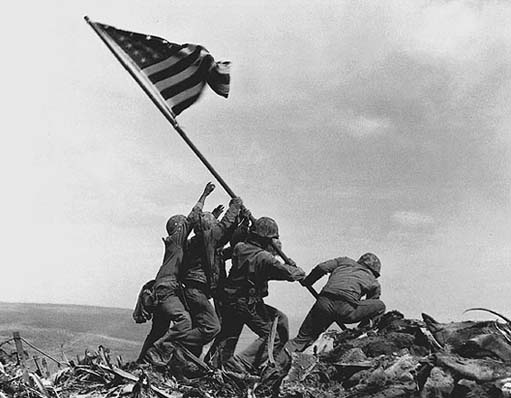4.2 Nation and identity
Yet even if photographs are an ‘evidential trace’ of the reality they depict, they are far from perfect in this respect. Because a photograph could always have been made differently it cannot be ‘the whole truth’ about something (Becker, 1985, p. 101). If we think about photographs designed to inform (i.e. rather than art photographs in which questions of truth or reality are really not at issue) it will be obvious that the photographer's choices have determined what sort of ‘evidential trace’ the image may constitute. Let's look at an example (Figure 7).

This photograph is part of the documentary archive about the people and landscape of North Devon made by James Ravilious (Hamilton, 1998, p. 2).
It may seem obvious to say that this is a picture about national identity, about ‘Britishness’ (or maybe ‘Englishness’). Ravilious gives the flag full prominence: it is being raised to celebrate the Silver Jubilee of Queen Elizabeth's accession to the throne. Notice how he has carefully framed the image so that the men appear quite small in relation to the scene and in particular to the flag. The large flag will wave, once erect, over a ‘typically English’ landscape of small fields, hedgerows, hills and woods – and perhaps typically again, the sky is cloudy and dark for it will soon rain again (notice that all four men wear boots). The composition is quite dramatic and forceful since the flag, pole and men are disposed along the diagonal of the picture. The Union Flag is in a ‘dominant third’ of the image, which we tend to ‘read’ from left to right, so we know at first look that this is a picture ‘about’ nationality. Taking the photograph in black and white has emphasised the graphic aspects of the image, simplifying it to a palette of greys.
We can interpret the photograph in a number of ways, but our ‘reading’ will offer answers to certain questions. Clearly, these have to do with national identity, with the nature of a rural community, with gender, and with the ritual of a national celebration. The photograph offers information about how people in rural Devon celebrated the Silver Jubilee in 1977. It tells us some interesting things about one aspect of their conceptions of nationality (they celebrated by raising the Union Flag). It also tells us about whose role it was to do this – young white men – and that the event was sufficiently distinctive a feature of that community that a photographer chose to record it, and tried to make an impressive picture of this small-scale event. It is intriguing to note that Ravilious's picture may also have been an unconscious ‘homage’ to another and more famous image, Joe Rosenthal's 1945 photograph of US marines raising the US flag on Iwo Jima's Mount Suribachi (Figure 8). This is an even more explicit reference to national identity, and to its reaffirmation through conflict and force of arms.

If the Devon flag-raising photograph is a picture about ‘Englishness’ or ‘Britishness’, it has not been created by accident. The photographer has chosen to make the picture in a certain way, which is faithful to the event, but is only one of an infinite number of pictures that might have been taken. What is left out of the picture may in many ways be more significant than what is left in. It might have been more effective if a crowd of spectators had been included, or some village houses had figured in the scene: but the photographer did not choose to include these things. This might seem like a disadvantage since it ‘distorts’ the image we can read from this photograph – but how often, as social scientists, would we be content to construct an entire theory of national identity from one item of documentary evidence? The answer is never.
The photograph, then, is only one piece of evidence of how national identity might be celebrated in a rural community. The photograph can answer some questions about that, but not others. At the end of the day, it tells us quite a limited number of things. We have to rely on the reputation of the photographer to establish that it was a genuine document, that he did not ask these men to turn up at a particular place with a purpose-bought flag to make just such a picture – perhaps years after the Jubilee. (This is like trusting that a social scientist has not falsified his or her data.) If we want to understand the nature of community life in North Devon villages in the late 1970s, then photographs like this one would help us to construct a sociological theory about the structure and organisation of communal existence. We would need to look at many photographs and at many other pieces of data, but there is no doubt that the visual evidence – subjected to the type of analyses outlined above – would constitute a significant help in the process of understanding.
